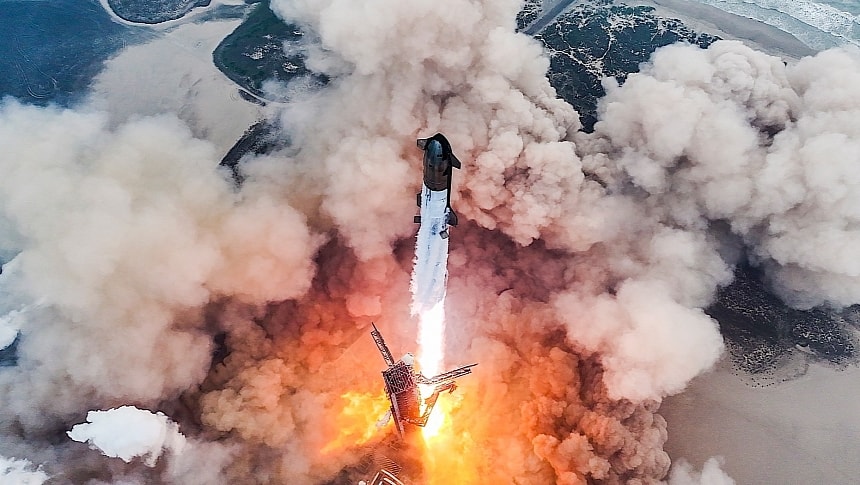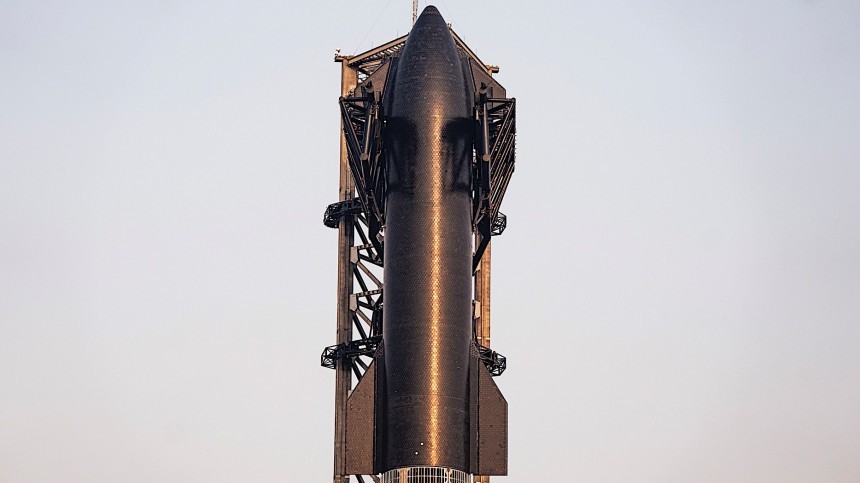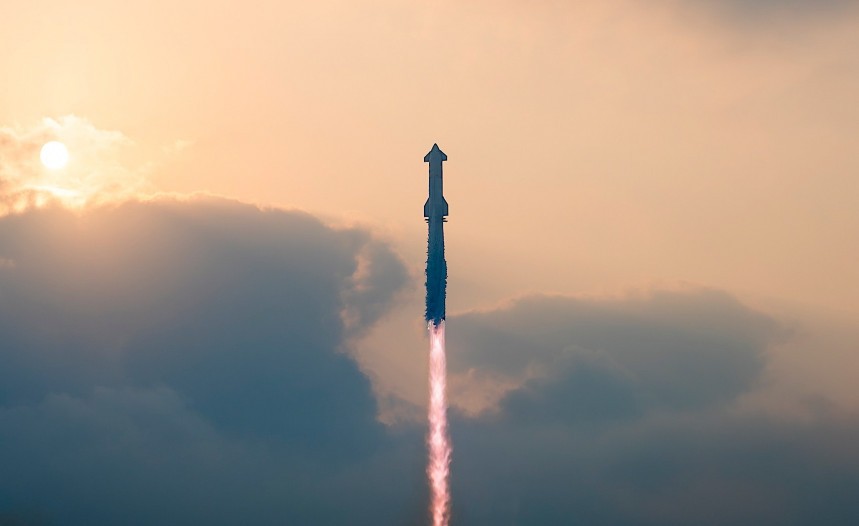Four times is a charm, said no one, ever. Until yesterday, that is, when Elon Musk’s SpaceX managed to launch the newest spacecraft around, the mighty Starship, on its first-ever complete flight.
On the same day Boeing managed to finally dock its Starliner spacecraft to the International Space Station (ISS), SpaceX managed to steal the headlines, overshadowing the achievement of the troubled American aerospace giant by sending the Starship twice as high as the Karman line, and then bringing it back to Earth.
Three times before the Starship launched and ended in apparent disaster. The last time it did that, back in March, the spacecraft that is meant to open the doors to interplanetary travel was destroyed in a glorious explosion caused by the detonation of its carrier rocket, the Super Heavy booster. during separation.
On June 6, SpaceX had another shot at it. At exactly 7:50 a.m. CT, the Super Heavy left the pad at the company’s Starbase in Texas, once again performing a full-duration ascent burn. When the time was right, at an altitude of 46 miles (74 km), the spacecraft perched on top of it conducted a hot-stage separation.
What that means is that just three of the world’s most powerful launch vehicle’s 33 Raptor engines were powered down, and the six engines on the second stage were ignited.
Separation followed, with the Super Heavy performing a flip maneuver to head back down to Earth, and the Starship moving further up into the atmosphere. Seven minutes and 24 seconds into the flight, the booster made a soft splashdown in the Gulf of Mexico.
Meanwhile, the spacecraft continued to climb, reaching an altitude of about 124 miles (200 km) and a top speed of 16,000 mph (25,750 kph). At these hypersonic speeds the craft entered Earth’s atmosphere and began its controlled descent.
SpaceX says that during this stage of the flight the Starship made it “through the phases of peak heating and max aerodynamic pressure” and demonstrated “the ability to control the vehicle using its flaps.”
66 minutes after liftoff, the spacecraft used its three center Raptor engines to flip and then perform a soft splashdown as well, this time somewhere in the Indian Ocean.
The fourth flight of the Starship was by no means a perfect one. The mission appears to have started with 32 of 33 Super Heavy Raptor engines operational at launch. Then, during re-entry, some of the tiles on the ship’s heat shield were lost and its forward flap ignited.
It was, thus, an imperfect launch, but one that perfectly fits into the development schedule for the Starship. The company plans to use the data from flight four to advance its goals of creating a fully reusable space transportation system that could advance our colonization of the Moon and open the doors to humanity’s first trip to Mars, and perhaps even beyond.
When it will be ready for operation, the Starship will surely be a sight for the ages. Its carrier rocket, the Super Heavy, is powered by sub-cooled liquid methane (CH4) and liquid oxygen (LOX), generating 16.7 million pounds of thrust at takeoff, more than any other rocket before it,
thanks to its huge army of 33 Raptor engines.
With this immense power at its disposal, the rocket will be capable of lifting 150 metric tons of cargo, but that could potentially be expanded to as much as 250 metric tons.
Part of that weight is the Starship spacecraft itself. For now we’re only treated to prototypes, but it will eventually be produced in several configurations. They will come with an integrated payload section for cargo, but will also have room for crew.
Although it was technically devised as a means to reach space and other worlds, SpaceX is also pondering another potentially life-changing use of the Starship: a means of transport for people here on Earth.
The vehicle would launch as it normally does, climb into orbit, and then come down to land at its destination. In theory, this should put any place of this world within under an hour of travel time.
A variant of the Starship called the Human Landing System (HLS) will be used to support the NASA Artemis III mission to the Moon. The hardware would launch from Earth ahead of the astronaut-carrying Orion spacecraft and park itself in orbit around the Moon, awaiting the arrival of humans.
Once there, astronauts will take the Starship down to the surface of the Moon and then back up again, marking the first-ever real-life use of the hardware we just witnessed making its first successful flight.
We still have a long to go until we reach that point, though, as Artemis III is not scheduled to depart before 2026. In the meantime we’ll probably witness increasingly perfect test flights, if there ever was such a thing.
Three times before the Starship launched and ended in apparent disaster. The last time it did that, back in March, the spacecraft that is meant to open the doors to interplanetary travel was destroyed in a glorious explosion caused by the detonation of its carrier rocket, the Super Heavy booster. during separation.
On June 6, SpaceX had another shot at it. At exactly 7:50 a.m. CT, the Super Heavy left the pad at the company’s Starbase in Texas, once again performing a full-duration ascent burn. When the time was right, at an altitude of 46 miles (74 km), the spacecraft perched on top of it conducted a hot-stage separation.
What that means is that just three of the world’s most powerful launch vehicle’s 33 Raptor engines were powered down, and the six engines on the second stage were ignited.
Separation followed, with the Super Heavy performing a flip maneuver to head back down to Earth, and the Starship moving further up into the atmosphere. Seven minutes and 24 seconds into the flight, the booster made a soft splashdown in the Gulf of Mexico.
SpaceX says that during this stage of the flight the Starship made it “through the phases of peak heating and max aerodynamic pressure” and demonstrated “the ability to control the vehicle using its flaps.”
66 minutes after liftoff, the spacecraft used its three center Raptor engines to flip and then perform a soft splashdown as well, this time somewhere in the Indian Ocean.
The fourth flight of the Starship was by no means a perfect one. The mission appears to have started with 32 of 33 Super Heavy Raptor engines operational at launch. Then, during re-entry, some of the tiles on the ship’s heat shield were lost and its forward flap ignited.
It was, thus, an imperfect launch, but one that perfectly fits into the development schedule for the Starship. The company plans to use the data from flight four to advance its goals of creating a fully reusable space transportation system that could advance our colonization of the Moon and open the doors to humanity’s first trip to Mars, and perhaps even beyond.
When it will be ready for operation, the Starship will surely be a sight for the ages. Its carrier rocket, the Super Heavy, is powered by sub-cooled liquid methane (CH4) and liquid oxygen (LOX), generating 16.7 million pounds of thrust at takeoff, more than any other rocket before it,
thanks to its huge army of 33 Raptor engines.
Part of that weight is the Starship spacecraft itself. For now we’re only treated to prototypes, but it will eventually be produced in several configurations. They will come with an integrated payload section for cargo, but will also have room for crew.
Although it was technically devised as a means to reach space and other worlds, SpaceX is also pondering another potentially life-changing use of the Starship: a means of transport for people here on Earth.
The vehicle would launch as it normally does, climb into orbit, and then come down to land at its destination. In theory, this should put any place of this world within under an hour of travel time.
A variant of the Starship called the Human Landing System (HLS) will be used to support the NASA Artemis III mission to the Moon. The hardware would launch from Earth ahead of the astronaut-carrying Orion spacecraft and park itself in orbit around the Moon, awaiting the arrival of humans.
Once there, astronauts will take the Starship down to the surface of the Moon and then back up again, marking the first-ever real-life use of the hardware we just witnessed making its first successful flight.
We still have a long to go until we reach that point, though, as Artemis III is not scheduled to depart before 2026. In the meantime we’ll probably witness increasingly perfect test flights, if there ever was such a thing.










